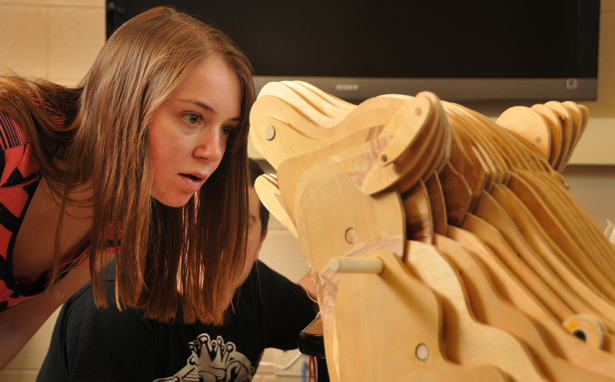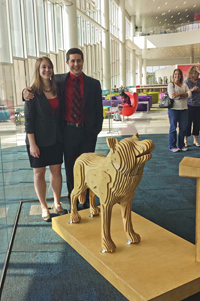Howling Robots: One Student’s Path From the Classroom to the Theme Park

Editor’s Note: This is a guest post by Tim Peeler, who writes for NC State University Communications.
Now that she’s the co-creator of a robotic wolf, Michelle Phillips’ career path into the field of animatronics seems obvious. But that wasn’t always the case.
Phillips had only been at NC State for a couple of semesters when she discovered that she really didn’t like biology. This put a real crimp in her plan to get a biomedical engineering degree and work as a tissue engineer.
“When I decided to get out of biomedical I had to figure out what I was going to do with my life,” Phillips says.
To chart her path forward, she turned back to her childhood, and the trips she had made to Disney World and Universal Studios, switching from biomedical to mechanical engineering.
“I thought becoming a ride engineer would be about the coolest thing in the whole world,” she says.
Like many NC State engineering students, she participated in the Disney ImagiNations competition, which lets students develop potential new attractions for the company. Phillips’ team made it to the semifinals of the competition with their concept of an interactive theme park based on Brazilian folklore.

After the competition, Phillips began working with the American Society for Testing and Material’s F24 subcommittee, which is responsible for safety standards that oversee all amusement rides and devices. At one of its biennial meetings, she met Universal Creative’s Steve Blum, who offered her an internship in Orlando last summer. She spent her time working on animatronic figures that will be part of a $400 million expansion to the Wizarding World of Harry Potter. She was offered and accepted a full-time job with the theme park when she completes her degree in mechanical engineering in May.
It’s the perfect career for Phillips, who grew up waiting for each new installment of J.K. Rowling’s fantasy books about the lightning-scarred wizard and his friends.
“I was definitely in that generation that all read the books and kind of expected a letter from Hogwarts in the mail any day,” Phillips says.
Instead, she received a letter inviting her into the Honors Program at NC State, a research-focused program that expects its students to experience what they learn as active participants in their chosen field. After switching into mechanical engineering, Phillips began preparing for a career in the theme-park industry.
When she came back from Orlando last summer, she and fellow student Kevin Young began working on their honors capstone project, which is required of all Honors Program students. Instead of modifying their senior design projects, as many engineering students do, Phillips and Young sought help from other parts of campus to build a working animatronic wolf.
Young and Phillips, who used the knowledge she gained at Universal, helped the project stay focused on what was possible. All the while, they continued to work on their senior engineering project: a device that uses a vacuum chamber to detect possible leaks in canned food for the Food Bank of North Carolina.
With the help of enrichment and undergraduate research grants, Phillips and Young worked with students from other disciplines for the last nine months to build a 4-foot, 120-pound interactive statue that was recently unveiled on the second floor of the Hunt Library on NC State’s campus.
Visitors can use a control panel to make the wolf – constructed of Baltic birch plywood and three heavy motors – simulate a howling motion.
It was an elaborate undertaking. Even their mentor, engineering professor Larry Silverberg, was skeptical of the project’s viability.
But they checked out a 3-D scanner from the library, scanned a $3 plastic wolf they bought at a toy store, loaded their data into computer-aided design software and used a 46,000 psi waterjet cutter to create a fully working canine masterpiece that they plan to leave behind for future students.
It might not be as fancy as some of the animatronics that will thrill Harry Potter lovers this summer, but it is a tangible legacy for Phillips’ work as an undergraduate engineer.
- Categories:


